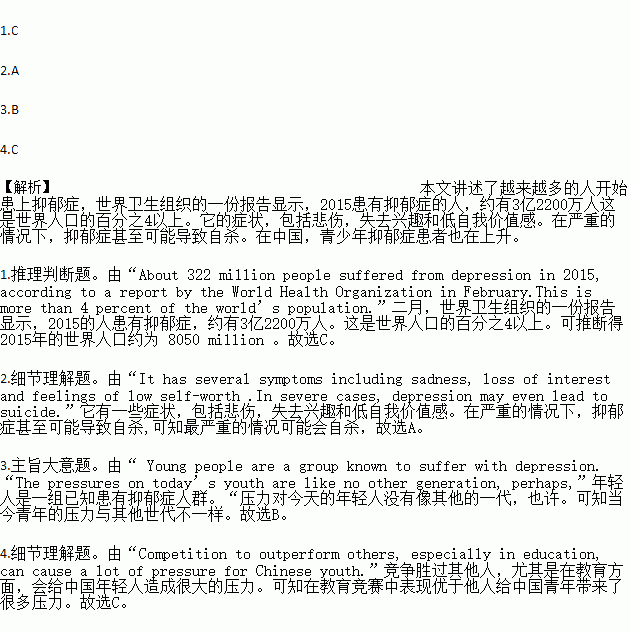题目内容
While we all try to find happiness, sometimes we still end up feeling low. While most people can control this feeling, low moods can stay with some, leading to depression. About 322 million people suffered from depression in 2015, according to a report by the World Health Organization in February. This is more than 4 percent of the world’s population.
Depression is described by the WHO as a mental disorder. It has several symptoms including sadness, loss of interest and feelings of low self-worth. In severe cases, depression may even lead to suicide.
The number of people living with depression is increasing. The WHO reported a rise of 18.4 percent between 2005 and 2015. Young people are a group known to suffer with depression. “The pressures on today’s youth are like no other generation, perhaps,” Dan Chisholm, an official of WHO, told Reuters.
In China, depression among young people is on the rise, Zhu Zhuohong, a psychology professor with the Chinese Academy of Sciences, told Xinhua News Agency. Competition to outperform others, especially in education, can cause a lot of pressure for Chinese youth.
Almost 1.2 million Chinese people aged 15 to 24 suffer from depression, according to a report released by British science journal The Lancet in May.
Luckily, more and more efforts are being made to deal with this problem. This year’s World Health Day, held on April 7, will focus on depression. The day will highlight (强调) the “Depression: let’s talk” campaign. The campaign aims to make sure that people with depression both seek and get help.
1.According to the passage, what was the population of the world in 2015?
A. about 322 million B. about 128.8 million
C. about 8050 million D. about 18.4mill ion
ion
2.Which symptom is the worst among several symptoms?
A. suicide B. loss of interest
C. sadness D. feelings of low self-worth
3.What does the 3rd paragraph tell us?
A. The pressures on today’s youth are the same as other generations.
B. The pressures on today’s youth are not the same as other generations.
C. The pressures on today’s youth are bigger than other generations.
D. The pressures on today’s youth are not bigger than other generations.
4.What cause a lot of pressure for Chinese youth?
A. Competition between young generations
B. Competition to outperform others
C. Competition to perform better than others in education
D. Education to avoid disorders
| A. | to keep | B. | to have kept | C. | keep | D. | have kept |


 B. proved C. doubted D. showed
B. proved C. doubted D. showed _________________________________________________________________________________________________________________________________________________________________________________________________________________________________________________________________________
_________________________________________________________________________________________________________________________________________________________________________________________________________________________________________________________________________ ),并在其下面写出该加的词。
),并在其下面写出该加的词。 tion is more important today than ever before .In Canada mostly children attend public schools. Public schools are mainly found by governments through tax income. Students in Canada taught in English and in French. The rests of Canadian children attend private schools, that are supported mainly by fees paying by parents .By law ,the children must attend the school from age 5 to 16. There are several different levels in the Canadian education system .The first was called Elementary Schools ,which includes kindergartens through grade 7 or 8.
tion is more important today than ever before .In Canada mostly children attend public schools. Public schools are mainly found by governments through tax income. Students in Canada taught in English and in French. The rests of Canadian children attend private schools, that are supported mainly by fees paying by parents .By law ,the children must attend the school from age 5 to 16. There are several different levels in the Canadian education system .The first was called Elementary Schools ,which includes kindergartens through grade 7 or 8. eates pollution by releasing greenhouse gases. This affects the air we breathe and our quality of life.
eates pollution by releasing greenhouse gases. This affects the air we breathe and our quality of life.